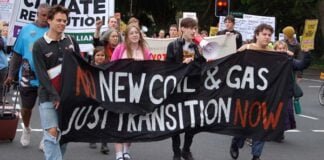The Carbon Pollution Reduction Scheme (CPRS) is the Rudd government’s central policy for dealing with climate change. The gap between rhetoric and reality is revealed starkly by a looking at how the scheme is supposed to work.
How does ‘cap and trade’ work?
The CPRS is a “cap and trade” system that sets a limit on total annual emissions. In total 1000 companies will be forced to participate, covering stationary energy, transport, industrial processes, waste and “fugitive emissions”—such as waste emissions in oil and gas production. The number of tradable carbon pollution permits will be equal to the scheme cap—if the cap were to limit emissions to 100 million tonnes of carbon dioxide equivalent (CO2-e) in a particular year, 100 million emissions permits would be issued for that year. The 1000 companies will be obliged to have a permit for each tonne of CO2 they emit. Companies are responsible for reporting their own emissions to the government—there is no central mechanism or body to police them. Affected industry has been promised five years’ notice to any changes in the scheme.
The targets
The cap is 5 per cent below 2000 levels by 2020 or 15 per cent by 2020 in the context of global agreement at Copenhagen in December.
The scientific consensus is that cuts of 40-60 per cent by 2020 is the minimum required to stop runaway climate change. Another way of looking at it is that the carbon ‘parts per million’ (ppm) in the atmosphere need to be stabilised between 300-350ppm. The government claims their targets are consistent with a 550ppm target—however the ANU’s Centre for Climate Law assesses them as closer to a 650ppm plan.
Money for polluters
Free permits and cash handouts will be given to the big polluters.
“Emissions-intensive trade-exposed” (EITE) industries, producers of goods for export, will be given 90 per cent of their permits free. Some other businesses will get 60 per cent of their permits free This amounts to $7.4 billion compensation in the first two years.
EITE industries have been told their free permits will increase if they grow by more than expected, allowing polluting industries to continue to expand.
A further $2.25 billion will go mostly to coal-fired power stations in direct cash assistance, untied to any requirement to transition to renewable energy.
There are concerns that defining pollution permits under the scheme as property rights will subject future governments to compensation claims if they try to tighten targets.
Individual action
The CPRS also negates any emissions reductions made outside the scheme. In setting a cap it also sets a floor. Individual actions, like putting solar panels on your house, will actually free up permits, enabling business to emit more. For example, if an individual installs a solar hot water system to reduce their climate impact, the use of electricity will fall as a result and the electricity company will have fewer emissions and need less permits. They will sell on their leftover permits, allowing other companies to buy them and emit more pollution.
Where will the cuts be made?
Emissions trading has no regard to the “how” or the “where” of emissions cuts. Companies that can reduce emissions most cheaply will do so and sell their permits onto those for whom reductions would be costly. This discourages overall structural change, which is much more expensive in the short term. Rather than incentives for investment in systematic change in energy systems, it provides incentives for business as usual. Big polluters can buy their way out of action for the foreseeable future.
Offsets
Companies can purchase an unlimited number of permits from offshore under the scheme. This means that polluting industries in Australia can pay for projects that “reduce emissions” overseas, such as tree plantations, instead of reducing pollution at home. One study of around 3000 offsets found over half were scams or would have happened anyway.
Who pays?
The scheme is based around the idea that big companies will pass increased production costs onto consumers. This entrenches the principle that working class people, who are already facing cuts to living standards, must pay the ultimate costs of reducing emissions.
This approach will endanger public support and be exploited by the right, who claim that acting on climate change will cost jobs. But it doesn’t have to—it should mean the opposite.
We should be calling for dirty fossil fuel plants to be shut down and for direct government investment into such infrastructure—with all affected workers to be given well paid, unionised “green jobs”. This can be complemented with a massive expansion of public transport, reforestation, and a massive roll out of energy efficiency measures. A report by CSIRO indicated 2.5 million green jobs could be created by 2025 in Australia if such a strategy was followed.
By Amy Thomas





